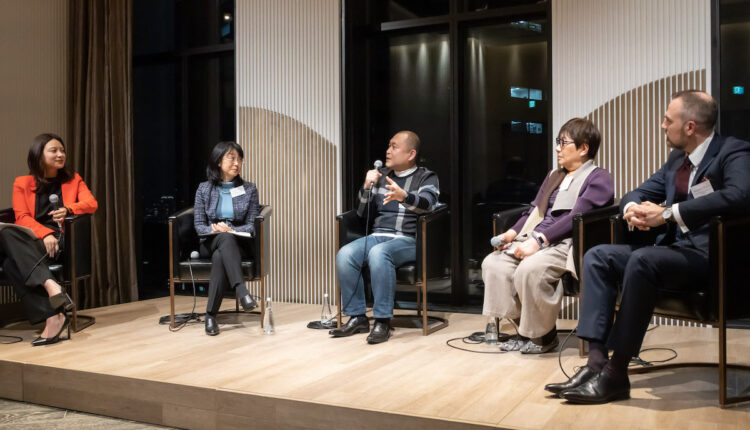In our last Growing the Pipeline of Diverse Talent event, we were joined by a group of experts for a panel discussion on the topic of diverse talent attraction in the Japanese market. Our panelists included Mika Matsuo, Executive Advisor at Asahi Group Holdings, Yulia Toyokawa, Managing Executive Officer at MUFG Bank, Shintaro Nakagawa, Interim General Manager at Uber Eats Japan and Alexander Jenner, a Senior Sales Team Manager at SThree.
Below we share some of the key takeaways from the conversation, that can be applied to support your organisation’s diverse talent attraction efforts.
What are some of the current trends in the Japan talent market?
- Flexibility
- As a result of the Covid-19 pandemic, companies had no choice but to provide a flexible working environment; now some companies are returning to pre-pandamic ways of working and some are retaining flexibility. This is a key consideration for prospective employees, particularly younger and female workers.
- Changing demographics
- The workforce demographics are changing in terms of age and gender, by 2025 Generation Z will constitute 30% of the workforce, and their needs and expectations are considerably different. Therefore, there is a growing need to adapt to their needs in order to attract them.
- Greater work mobility
- People are changing jobs more frequently than they used to – every 2 years is considered acceptable now. This means that employers need to be more intentional with their efforts to retain top talent.
How can organisations best respond to these trends?
- Flexibility & clarity regarding hybrid work
- Being inclusive but also clear about the working style – it can be considered important to come back to the office, however, there needs to be an explanation of the value of in-person time and to provide flexible options as well.
- Bespoke career approach
- Consider and adapt to the needs of Generation Z employees, who want faster career progression by providing more opportunities for career growth as well as for specialization within a particular field.
- Commiting to ESG and Diversity, Equity & Inclusion (DEI)DEI
- ESGs are now a crucial factor for choosing an employer, particularly for people that want to feel that their work is purposeful. Incorporate your ESG and DEI efforts into your employer branding efforts to attract the right talent, and then reflect on how you are progressing towards your goals.
What can companies do to differentiate themselves and attract the best quality talent?
- Clear value proposition communicated throughout the recruitment process
- Empowerment – the top management’s role is to set a clear vision but also to foster and encourage bottom up initiatives where employees can suggest and implement new things. It is important to build a culture where people feel safe to try and fail, and keep on trying.
- Investment in human capital – providing training programs at different career stages, including reskilling for mid-career hires, coaching, mentoring etc. It is crucial to empower employees to perform at maximum capacity in a new environment.
- Clear organizational purpose – Millennials and Generation Z are more passionate about contributing to the betterment of society and they need to believe in the organizational purpose. The organisational purpose should be a vital part of the business strategy that the top management communicates at every occasion, externally and internally.
How can organisations grow their talent pipelines by accessing under-utilized groups?
- Commitment to equity & publicity
- Commiting to choosing a member of an under-represented group when faced with a new-hire or promotion candidate equipped with the same amount of experience, and openly publicizing that preference.
- Making equity an organizational issue
- Instead of framing different issues as minority-issues they should be taken as organizational issues. In the case of women returning to work after childbirth, men also lose out on opportunities to take a more active role in family life. It is important to tackle the root causes – long working hours, parental leave adoption and flexible work arrangements.
Are there any creative solutions companies can adopt to attract diverse or under-represented talent?
- Referrals
- Good talent knows good talent and is connected in the under-represented groups; using monetary rewards for referring new hires and publicizing it can help as well.
- Being exclusive and targeted
- Creating opportunities to attract talent from a specific under-represented group and providing space for them to ask questions that normally might be avoided. In the case of tech, you can create women-only events targeted at changing the image of the industry as male-dominated.
- Removing the barrier between foreign and domestic companies’ mid-career hires
- For Japanese companies, it is important to welcome mid-career talent with foreign-company backgrounds too in order to diversify their environment and make it more comfortable for the next generations.
- Building an online network and welcoming returning talent
- Welcoming back talent who previously worked for the same company but left to work for another company, which used to be considered as a sort of “betrayal” but now can be utilized as a source of diverse perspectives and experience.
This event was brought to life in partnership with SThree. SThree is the global STEM-specialist talent partner that connects sought-after specialists in life sciences, technology, engineering and mathematics with dynamic organisations across the world. Visit sthree.com to know more about them.
Our events unite business leaders to discuss challenges and share knowledge amongst the global and Japan’s DEI community as a means of accelerating change.
If you would like to join our next event or learn more about DEI efforts in Japan, subscribe to our newsletter from the form below to hear about it first.









